Chinese Erotic Art
Erotic art – in letters and in pictures – is an eminent part of the cultural heritage of ancient China, and was already flourishing in pre-Imperial times. With its peak during the late-Ming period, this art remained a fixed feature in Chinese literature and visual arts until well into the 20th century.
At its best, Chinese erotic art is a search for beauty in all its manifestations, for not only does it offer stimulation, it provides a source of great aesthetic pleasure.
It never presents sex in a crude or pornographic way, but within a framework of beauty and harmony, enhanced with details of a profound or symbolic nature.
Yet it was precisely this kind of art, which was strictly prohibited and banned after upheavals of different governments. When the communists grabbed power in 1949, they made a definite end to the rich tradition of the erotic art expressions. Countless paintings and objects were destroyed during the ‘cultural cleansing’ of the communist rulers. Their puritan obsession knew no bounds.
After about 50 years of oppression, a massive interest in sexuality recently erupted in China. Tantalizing lingerie and a wide variety of stimulants is openly offered. Also prostitution is rampant again in bar, hotels and entertainment centres of the large cities.
Despite these developments, the current Chinese government is very sensitive to their cultural erotic heritage. Officially, ancient Chinese erotic art is still considered pornography and therefore forbidden.
New generations have no access to the philosophical and esoteric sexual culture of their ancestors. Sadly, most guidance and education in this field is provided on the Internet in the form of violent and humiliating Japanese porn movies, which are in all aspects, so radically different from – and often the opposite of – the traditional Taoist approach of subtle harmony.
Collections | Paintings, Albums and Scrolls
Love Poems
Wang Sheng
Complete album of 10 paintings on silk and 10 calligraphies op paper, dating from the late Ming period,
(1368 – 1644),
18 x 17 cm.
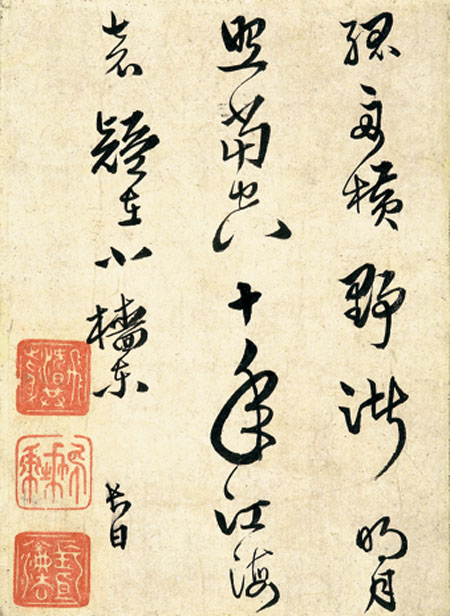
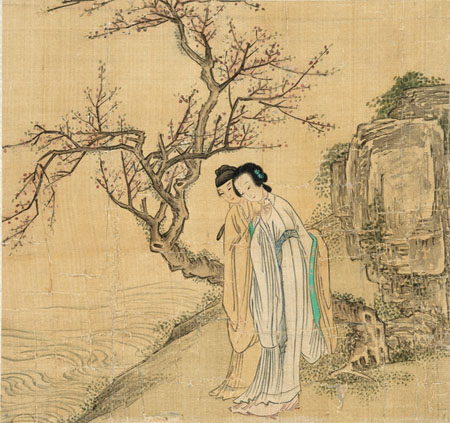
Gardens of Pleasure
Anonymous
Complete set of 8 paintings (formerly in the collection of C.T. Loo),
Kangxi period (1662 – 1722), ink and colour on silk,
39.5 x 55.5 cm.
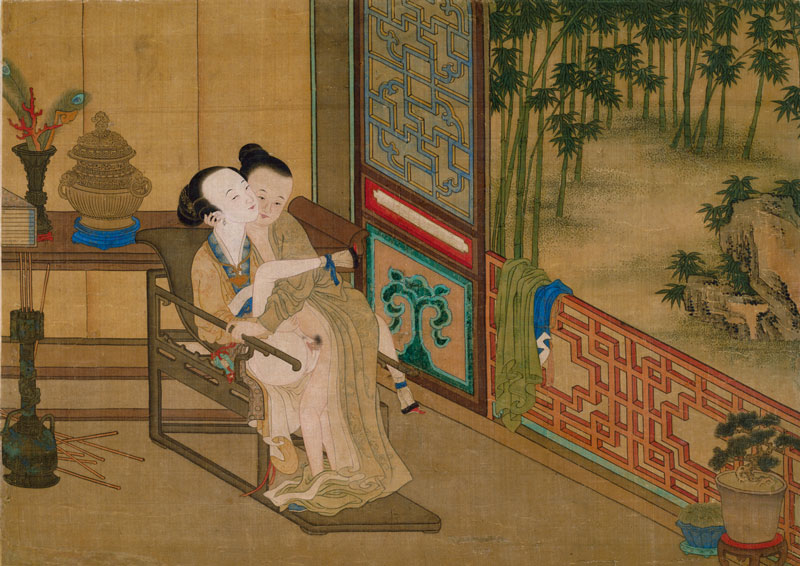
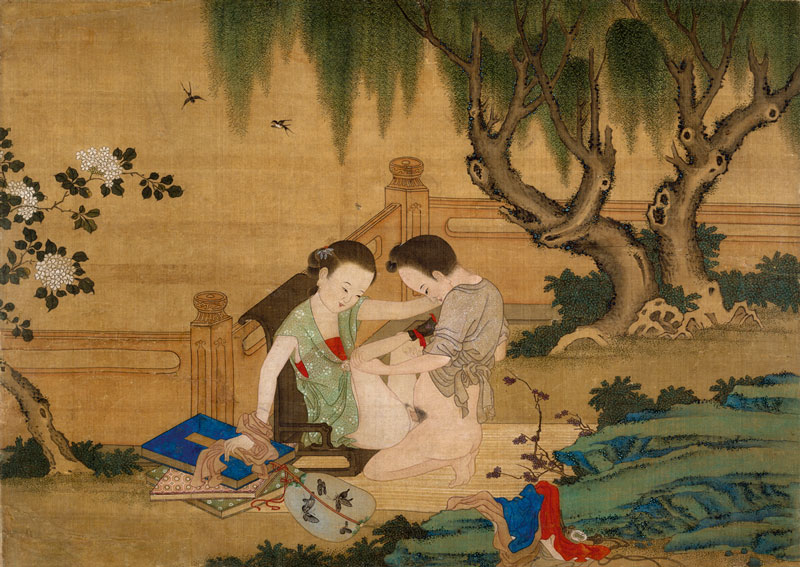
Scenes of Love
Anonymous
9 paintings, ink and colour on silk,
18th century,
38 x 34 cm.
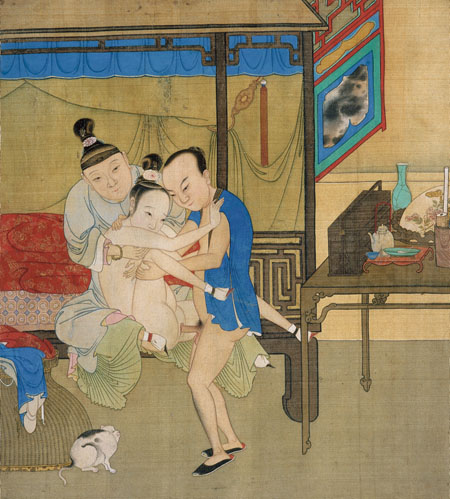
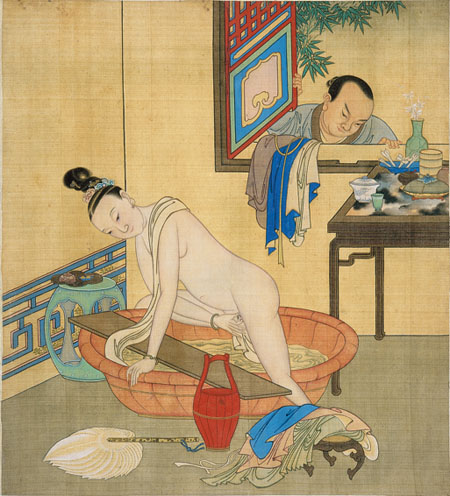
Rou putuan
(The Prayer Mat of Flesh)
Anonymous
12 paintings, ink and colours on paper,
18th century,
37.5 x 37.8 cm.
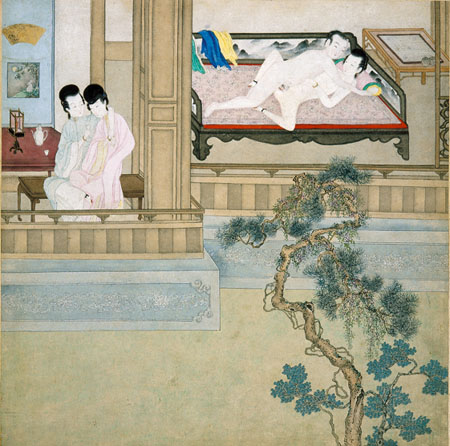
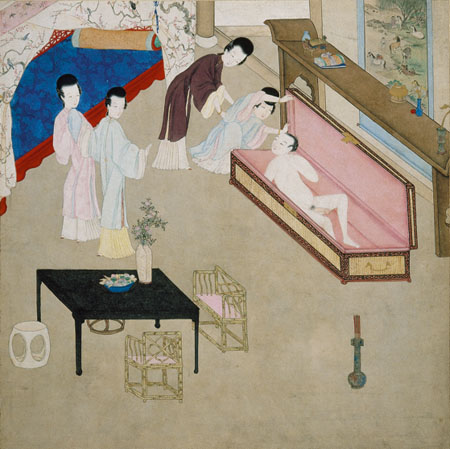
Yanqin Yiqing
(Intimate scenes of Love Games)
Anonymous
8 paintings, ink and colour on silk,
18th century,
38 x 41 cm.
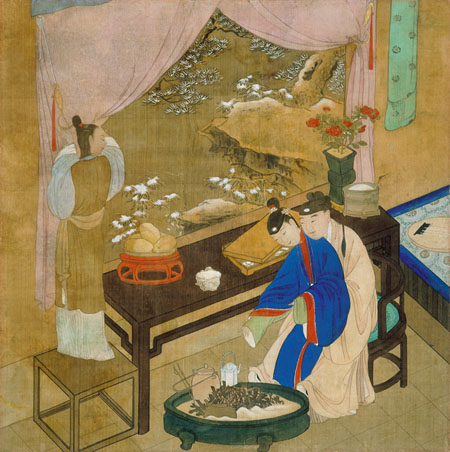
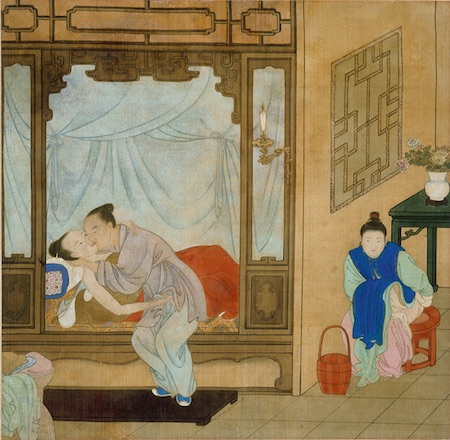
A Private Assignation
Xu Guan
Complete album of 12 paintings, ink and colour on silk,
18th century,
37 x 37.5 cm.
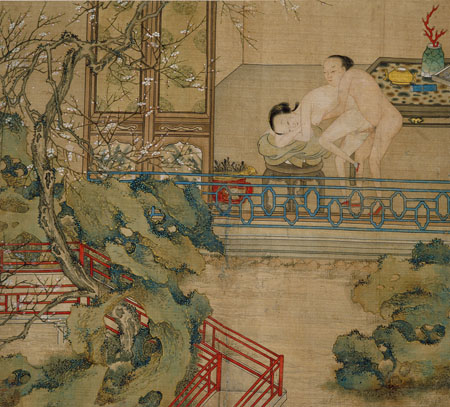
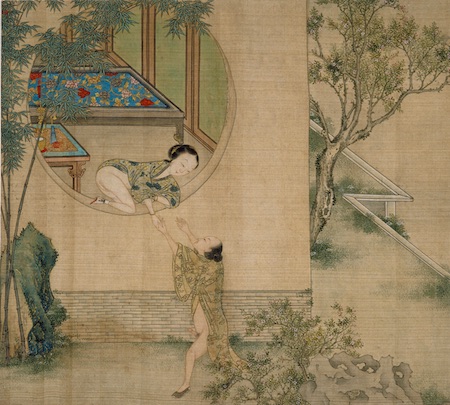
Meiren (Beauty) at her Bath
Anonymous
Hanging scroll, ink and colour on silk,
18th century,
155 x 87 cm.
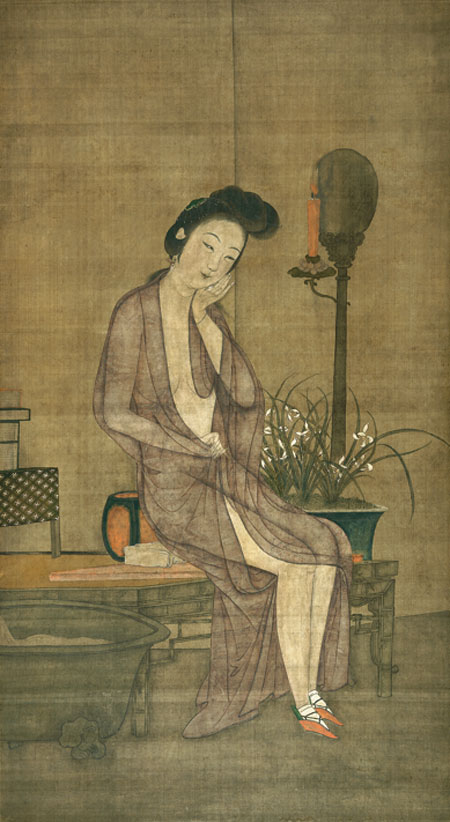
Xixiang ji
(History of the West Pavilion)
Anonymous
14 paintings and 12 calligraphies, ink and colours on paper,
early 19th century,
39.5 x 31 cm.
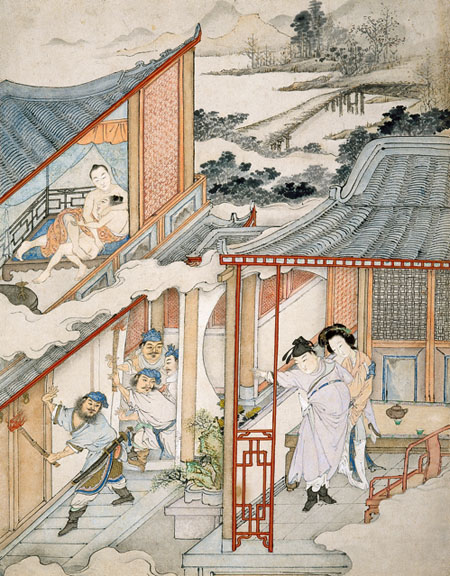
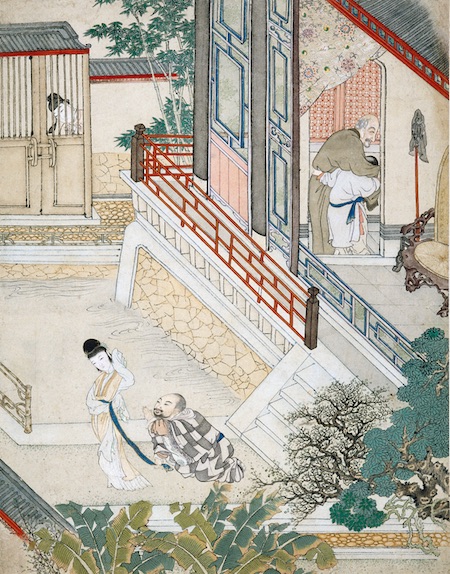
Studies (1773 – 1828)
Studio Gai Qi
7 sketches, ink on paper,
19th century,
various dimensions.
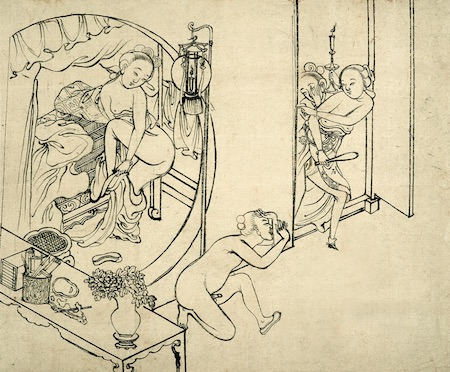
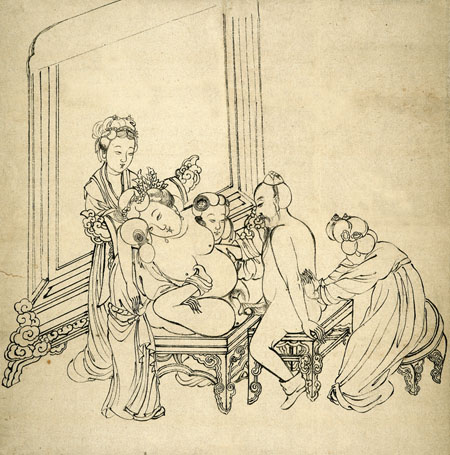
Subtile Pleasures
Anonymous
Complete set of 8 paintings, ink and colour on silk,
19th century,
26 x 22 cm.
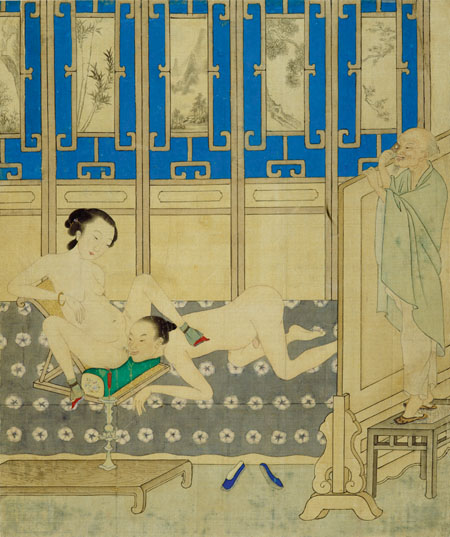
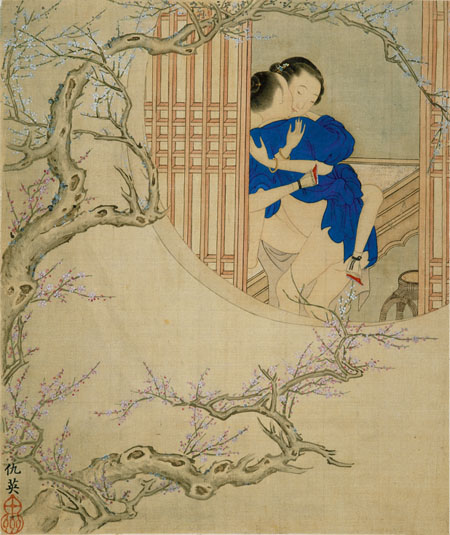
Love Games
Anonymous
5 paintings, ink and colour on silk,
19th century,
35.3 x 33.6 cm.
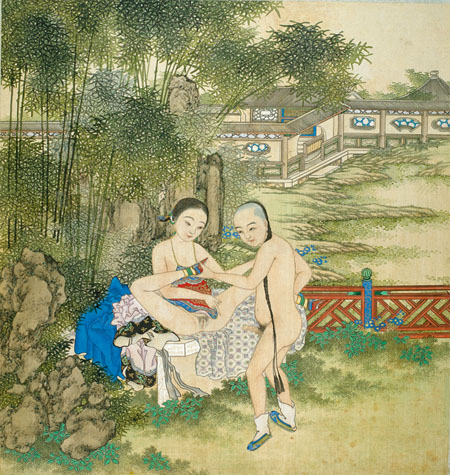
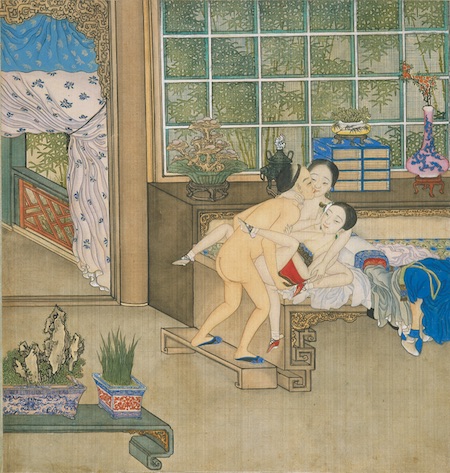
Collections | Objects
Phalluses of Stone, Ceramics and Bronze,
(c. 1100 – 250 BC.),
several dimensions.

Ivory Carvings, late Ming period,
(c. 1580-1644),
Couple on a Chair,
Two Doctor’s Ladies,
several dimensions.
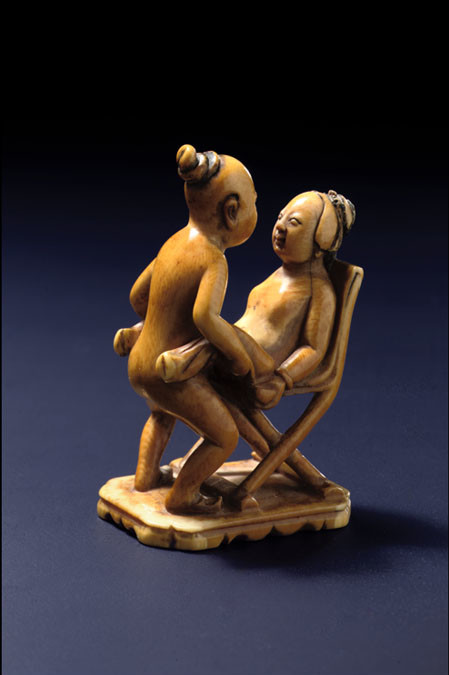

Ivory Panels,
18th century,
several dimensions.

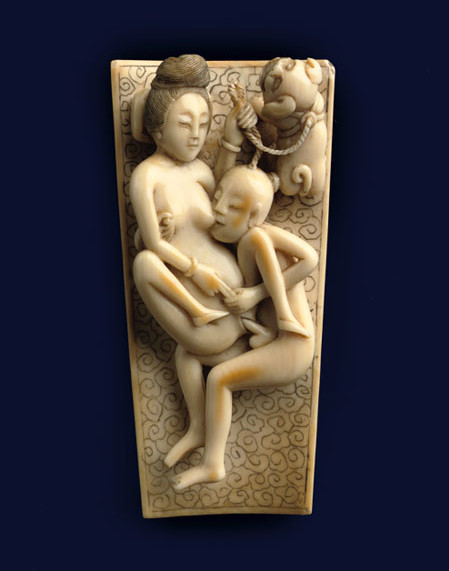
Bamboo Panels inlaid with Ivory and semi-precious sculpted stones,
18th century,
26 x 20 cm.


Porcelain Plates and Cups,
18th and 19th century,
several dimensions.
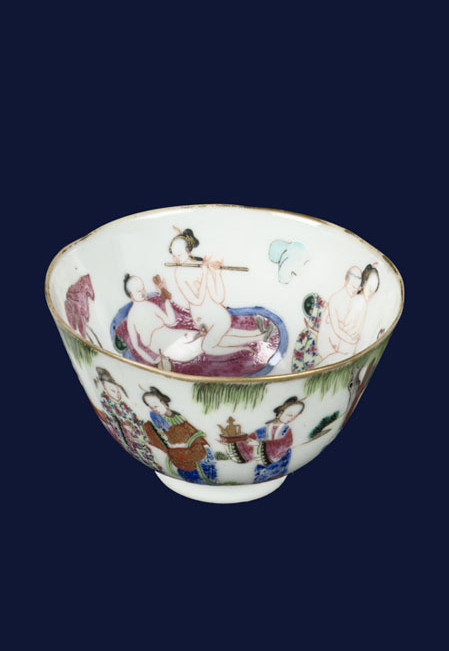

Porcelain Snuff Bottles,
18th and 19th century,
several dimensions.

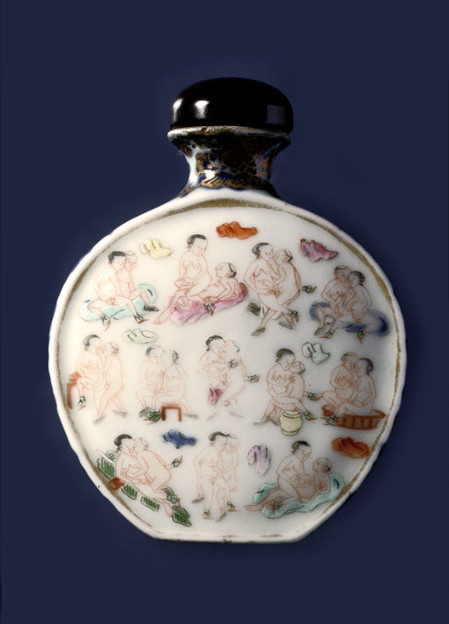
Porcelain Figures,
19th century,
several dimensions.


Reverse Glass Paintings,
19th century,
several dimensions.


Silk Lotus Shoes in various styles,
19th century,
7.5 – 15.5 cm.

‘Double Fans’ of paper, silk and lacquer work,
19th century,
ribs from 26.2 – 30.3 cm.

Gouaches on Pith Paper,
19th century,
23.4 x 18 cm.


Collections | Photography
Early 19th Century
Anonymous
Flower Girls and their Madams
Albumen Print, c. 1880,
20.8 x 26.5 cm.
Auguste Francois (1857 – 1935)
Funeral Procession at Yun-Nan-Fou
Gelatin Silver Print, 1902
11 x 16.4 cm.
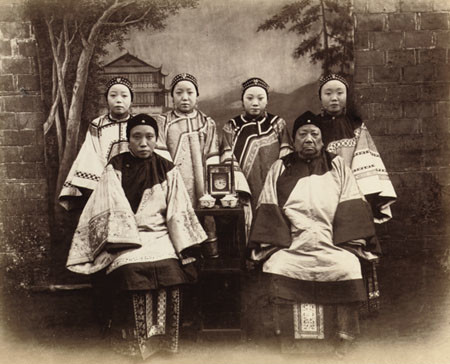

Publications
Publications:
- Dreams of Spring 1997
- Erotic Art in Ancient China, Taipeh 1999
- Chinese Sex Artifacts over 5000 years 2000
- Gardens of Pleasure 2003
- Liefde en Lentebloesems 2004
- Le Palais du printemps (Cernuschi) 2006
- Opium, Art en history of a lost ritual 2007
- L’Art d’aimer à la Chinoise, Paris 2007
- Concubines and courtesans, Women in Chinese erotic art 2010
- Among the Celestials, China in early photographs 2014
Magazines:
- Le nouvel observateur, Pariscope, Plumes, Orientations, Penthouse, Arts Asiatiques, Tableau, Génération Tao, Aladin, Édito, Accroches visuelles, Daily Telegraph, China Morning Post, etc.
Participations:
- A Hidden Love 2001
- L’Amour qui ose dire son nom 2001
- China Illustrata Erotica, Tokyo 2001
- Keramika, Princessehof 2002
- Liebeskunst, Museum Rietberg Zürich 2002
- Homosexuality in Art , New York 2003
- Homosexuality & Civilization 2003
- Homo Art, Köln 2004 Icons of Erotic Art 2004
- Seduced, Art & Sex from Antiquity to Now,
- Barbican Art Centre, London 2007
- La Nuit sexuelle, Paris 2007
- Changing Clothes in China, New York 2008
- Beauty Revealed, Images of Women in Qing Dynasty
- Chinese Painting 2013
Newspapers:
- Le Figaro, Le Monde, The Times, The Herald Tribune, China Morning Post, etc.
Het Opiumbed (The Opium Bed)
FERDINAND BERTHOLET
CATEGORY: Roman
EAN: 9789493280960
LONDONBOOKS, Amsterdam, 2024
EDITIONS: Dutch
After an Amsterdam artist purchases an antique opium bed, he receives penetrating visions about events that took place in China one hundred and fifty years ago. He gradually takes on the role of a student who falls hopelessly in love with the beautiful courtesan Kleine Bron during a visit to a brothel. Without her, his life has no value anymore.
The artist now starts a relationship with a young woman in whom he thinks to recognise his mistress from the past. When he ignores her warnings about the dangerous influence of the opium bed, she leaves him. Now nothing stands in the way of the artist to fully surrendering to the intoxication of the other side.
Ferdinand M. Bertholet (1952) is a visual artist and collector of Japanese and Chinese art. He has published five books on the art and history of China and has exhibited at The British Museum in London, Musée Cernuschi in Paris and the Museum für Asiatische Kunst in Berlin.
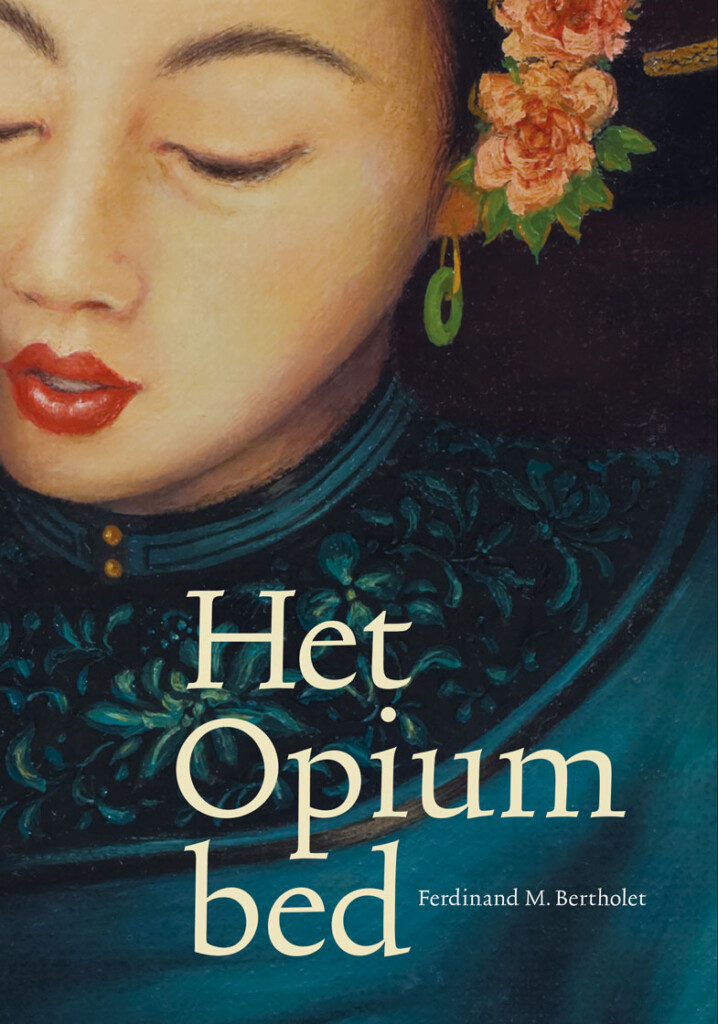
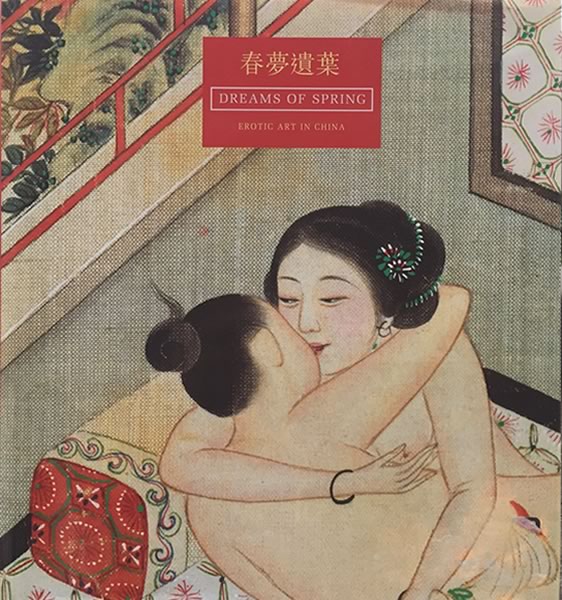
Dreams of Spring, Erotic Art in China
YIMEN & FERRY BERTHOLET
THE PEPIN PRESS, Amsterdam, 1997
ISBN: 90-5496-039-6
English, French, and German editions.
Erotic art – in letters and in pictures – is an eminent part of the cultural heritage of ancient China, and was already flourishing in pre-Imperial times. With its peak during the late-Ming period, this art remained a fixed feature in Chinese literature and visual arts until well into the 20th century.
At its best, Chinese erotic art is a search for beauty in all its manifestations, for not only does it offer stimulation, it provides a source of great aesthetic pleasure.
It never presents sex in a crude or pornographic way, but within a framework of beauty and harmony, enhanced with details of a profound or symbolic nature.
Dreams of Spring presents for the first time the treasures of the Bertholet Collection, one of the world’s most important surviving collections of Chinese erotic art. Many of the pictures reproduced are unique in their style and content, and have never been published before.
The text and descriptions in this book are the result of many years of scholarly research by one of the principal authorities in this field: Rev. Yimen, who studied Chinese history devoting herself to this neglected field of China’s spiritual traditions.
Gardens of Pleasure, Eroticism and Art in China
FERDINAND BERTHOLET & JACQUES PIMPANEAU
ÉDITIONS PHILIPPE REY, Paris, 2003
ISBN: 2-84876-007-9
PRESTEL Munich, London, New York, 2003
ISBN: 3-7913-2862-X
PS ITEMS, Harderwijk, 2004
ISBN: 90-77204-12-1
French, English, and Dutch editions
The erotic life of historical China – so different from Western sensibilities – can best be understood through the exceptional works of art which it inspired. From the 7th century onwards, a period which saw the emergence of China’s rich trading cities as well one of the most sophisticated societies in the world, Chinese ‘courtesan culture’ flourished, described and illuminated by dramatists, poets – and artists.
Drawing on the largest collection of Chinese erotic art in the world, this unique book initiates the reader into China’s intimate ‘gardens of pleasure’. Over one hundred of the most beautiful masterpieces from this golden age – many never before published – reveal the voluptuous secrets of a lost world. An essay by Jacques Pimpaneau traces the development of Chinese eroticism in its cultural context, emphasizing the influence of religions and historical events on sexual practises. Commentaries by Ferdinand Bertholet explain the cultural symbolism of the paintings.
Beautifully ornamented with poems contemporary with the paintings, this is a sumptuous collector’s volume and a tribute to the unknown masters of Chinese erotic art.
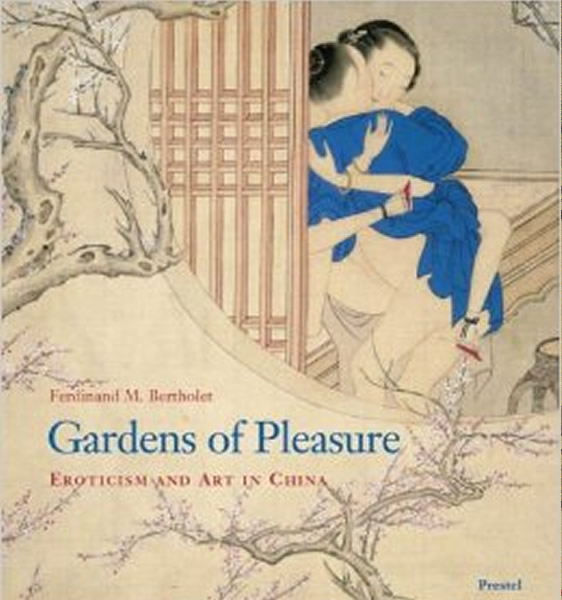
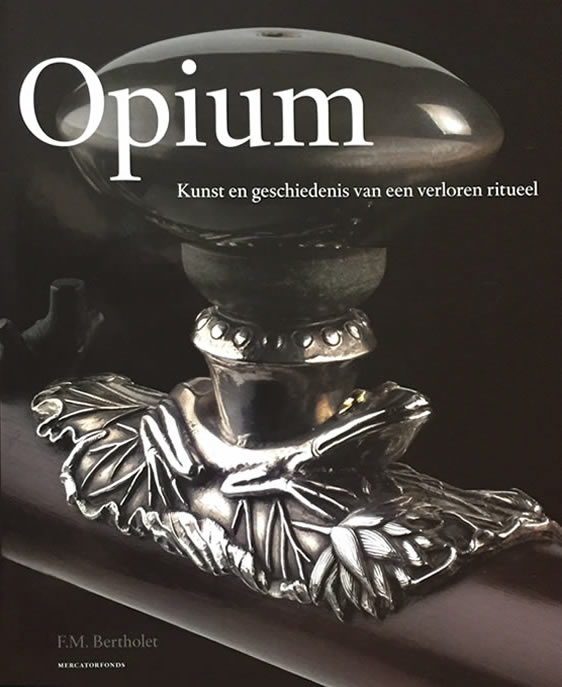
Opium, Art and History of a Lost Ritual
FERRY BERTHOLET
MERCATORFONDS, Brussels, 2007
ISBN: 978-90-6153-738-0
CITADELLES ET MAZENOD, Paris 2007
ISBN: 978-2850882425
Dutch, and French editions.
English edition in preparation.
Up to the present day opium has a magical attraction – the word ‘opium’ conjures up a mysterious world of adventure and gloomy romanticism.
Opium was long regarded as a gift from heaven. Descriptions can be found in classical academia of the miraculous effect of the sap that was extracted from the head of the poppy plant (Papaver somniferum).
It was recognized worldwide for its efficacy against various illnesses and in the easing of physical pain, and as such offered the possibility of escape from what might be an otherwise brutish reality. A number of writers, like Samuel Taylor Coleridge, Rudyard Kipling and Oscar Wilde, as well as expressive artists claimed to have drawn inspiration from visions they experienced whilst using opium. Nevertheless the darker side of this ‘luxury’ irrevocably condemns those who give themselves dissolutely to it: habit leads to dependency and once hooked, addicts find that there is no road back. It is this, above all, that has created the negative reputation surrounding opium. As a commercial commodity opium once had an enormous economic significance. It served the British as a lever in forcing the opening of the tightly closed gateway to the ‘Celestial Empire’ (China).
This sinister commercial policy almost led to the ruin of China, and since that time the Chinese have viewed opium as a symbol of foreign exploitation and humiliation. At the beginning of the twentieth century the use of and trade in opium was banned, with the result that pipes and their related accessories were destroyed on a massive scale.
One aspect that is still very much neglected in the numerous publications on opium is the material culture relating to the ritual of opium smoking. Within this cultural sphere, Chinese applied arts were given full and rich expression, most particularly in those objects that were created for wealthy upper-class merchants, scholars and nobility. The fascination with the unrivalled beauty of such applied arts has been the driving force behind us in bringing together, with great flair and passion, a number of striking and rare opium pipes and their paraphernalia.
We hope with this publication – in which a selection of art works from our collection is shown for the first time – to prevent a relatively unknown culture from sinking into oblivion.
Concubines and Courtesans, Women in Chinese Erotic Art
FERRY BERTHOLET
MERCATORFONDS, Brussels, 2010
ISBN: 978-90-6153-922-3
IMPRIMERIE NATIONALE ÉDITIONS / ACTES SUD, Arles, Paris 2010
ISBN: 978-2-7427-9356-3
PRESTEL Munich, London, New York, 2010
ISBN: 978-3-7913-4629-8
Dutch, English, and French editions.
Opulently illustrated Concubines and Courtesans offers a wide-ranging examination of erotic artifacts from the end of the Ming Dynasty, around 1600, to the heyday of Shanghai in the 1920s. It includes luxurious reproductions of prints, watercolours, oil paintings, ivory carvings, pottery, fans, and screens, among other items. The author gives a careful analysis of the history of erotic art in China and includes rare photographs on subjects such as foot-binding and prostitution. Examining these works as artifacts of Chinese culture, this book gives a uniquely comprehensive perspective on eroticism, romantic love, religious belief, and gender roles in Chinese history.
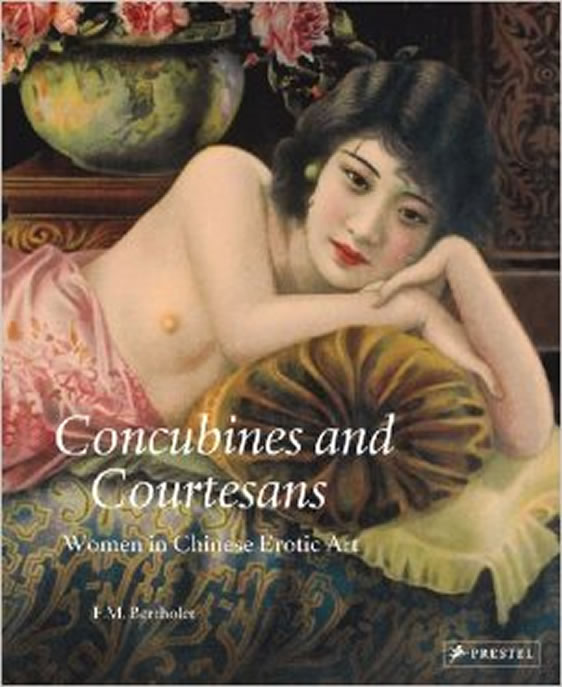
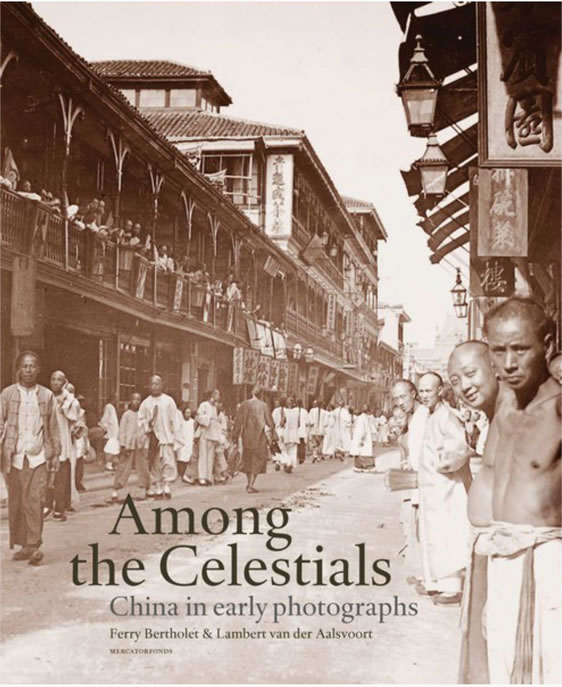
Among the Celestials, China in Early Photographs
FERRY BERTHOLET & LAMBERT VAN DER AALSVOORT
MERCATORFONDS, Brussels, 2014
ISBN: 978-94-6230-022-4
ÉDITIONS DE LA MARTINIÈRE, PARIS, 2014
ISBN: 978-2-7324-6506-7
FRÖHLICH & KAUFMANN VERLAG, Berlin, 2014
ISBN: 978-3-945330-04-3
English, French, and German editions.
Among the Celestials brings to life an intriguing period in Chinese history, through over 150 images of sublime beauty, many of which are reproduced here for the first time. The photographs evoke daily life in the Celestial Empire during the 19th century , when the Dragon Throne struggled to hold its ground. Its countless subjects, while clinging to ancient traditions, considered Westerners as barbarians, disturbing their Eternal Piece. The often daring efforts of Western and, later, also Chinese photographers offer us rare glimpses into a way of life that has long since disappeared.
Stunning portraits of both rich and poor, tantalising scenes of daily life and serene landscapes are presented here within a unique, comprehensive perspective, allowing each of the images to speak for itself. They reveal a stagnant, slumbering society that is slowly waking up to the needs of change and development. In the second part of this impressive volume a selection of striking photographs evokes the Republican period, when Chinese society begins to face these challenges.
Exhibitions
- Kunsthal, Rotterdam 1999
- Rietberg Museum, Zürich 2002
- Musée Cernuschi, Paris 2006
- Kunsthal Rotterdam (Art of Opium) 2007
- Barbican Art Centre, London 2007
- Museum für asiatische Kunst, Berlin, Dahlem 2011
- Nieuwe Kerk, Amsterdam (‘Ming’) 2013
- British Museum, London 2013
- Berkeley Art Museum, Berkeley 2013
- Art Gallery Sotheby’s, Hong Kong 2014
- Rijksmuseum, Amsterdam 2015
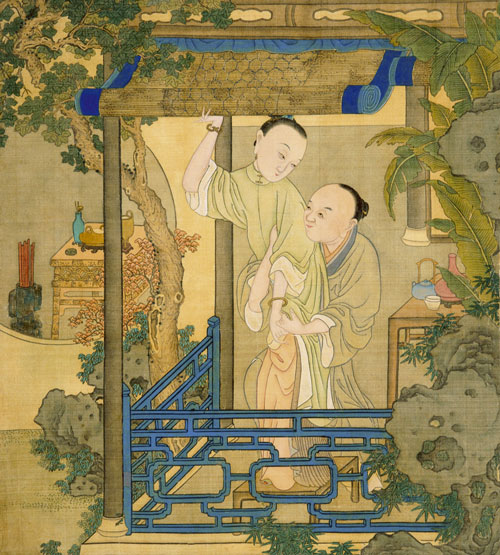
The Bertholet Collection

After completing his studies at the Dutch National Academy of arts, Ferdinand M. Bertholet (Amsterdam, 1952) made several long journeys through Asia. It was on one of these travels that he first encountered an album of Chinese erotic paintings, in an antique shop in Hong Kong. He was immediately struck by the subtle expression of romance and the harmonious composition and colouring of the works.
As he studied the subject further, and learned to recognize pieces of high quality, he found that good items had become very rare. Nevertheless, he began an impassioned search for top quality Chinese erotic paintings, ivory carvings and porcelain, which lasted for more than 35 years, and resulted in what is now generally regarded as the largest and most important collection of its kind.
Over the years several major museums have organized exhibitions in which parts of the Bertholet collection were presented.
